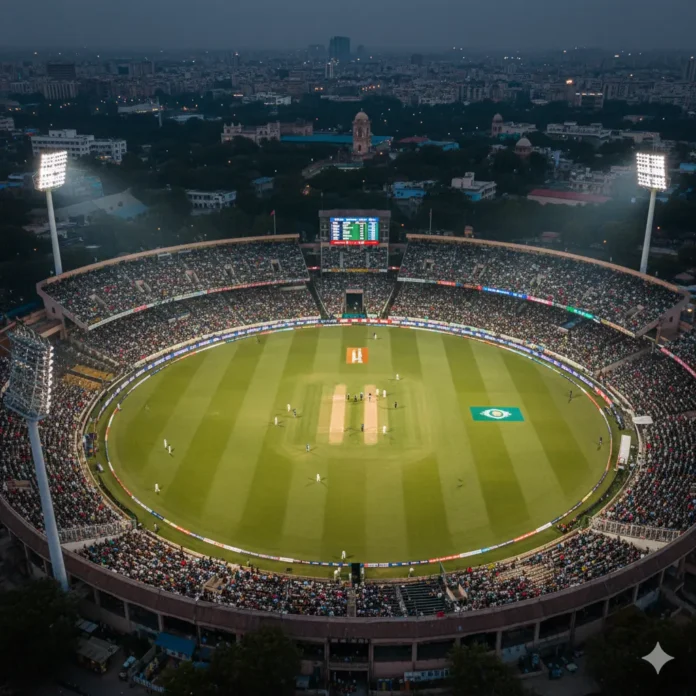Delhi remains one of the central points of Indian cricket. The city hosts stadiums with long histories, training grounds that nurture young players, and community fields that sustain the rhythm of local tournaments. For cricket in Delhi, venues are not only places of matches — they are instruments of preparation, testing, and discipline.
Delhi Cricket Stadium Name List: Core Venues
Officially, three names stand out in the delhi cricket stadium name list:
- Arun Jaitley Stadium (Feroz Shah Kotla)
- Roshanara Club Ground
- Palam Ground (Air Force Complex)
These are complemented by university and municipal grounds that hold school and district-level fixtures.
Arun Jaitley Stadium: International Stage and Local Symbol
The stadium, founded in 1883, is the oldest and most recognized cricket ground in Delhi. Its stands hold more than 40,000 spectators, and the pitch has seen milestones such as Anil Kumble’s ten wickets in one innings in 1999. For Delhi cricketers, the stadium represents not only history but also a benchmark.
Organization follows a strict order: advance ticketing, multiple entry points, and layered security. On match days, warm-ups are conducted on side pitches, and boundary ropes are adjusted to ICC standards. For academies, visiting the stadium is part of education — observing how professionals adapt to pressure from thousands of spectators.
Roshanara Club Ground: Domestic Cricket and Balanced Pitch
Located in North Delhi, Roshanara Ground is older than the BCCI itself. Here, Ranji Trophy fixtures and state-level competitions are common. Unlike international venues, the ground emphasizes function over spectacle: balanced wickets, limited stands, and close interaction between teams and officials.
For coaches, Roshanara’s wicket is a practical classroom. Seam bowlers test line consistency during Delhi winters, while batsmen are drilled to adapt to low bounce. Matches here follow a domestic routine: two umpires, official scorers, and clear time slots. For selectors, Roshanara performances carry weight — a steady fifty or four-wicket spell often matters more here than runs in a friendly league.
Palam Ground: Discipline under Limited Facilities
Palam, attached to the Air Force Sports Complex, hosts Services’ domestic games and practice sessions. Facilities are modest, seating is minimal, yet the ground plays a structural role. Conditions demand focus: no crowd distraction, no glamour — only game discipline.
A bowler’s task here is straightforward: hit length, extract movement, and work with fielders’ precision. Batsmen practice patience, often facing military-trained opponents who value fitness and consistency. For Delhi cricket, Palam proves that growth also comes from stripped-down environments where every run must be earned.
Secondary Grounds: Community Backbone
Beyond the main three, the city’s cricket heartbeat depends on community-level facilities. Siri Fort Ground, Jamia Millia Islamia University Ground, and Khalsa College fields hold school and inter-district matches.
The process is simple: morning inspection of pitch, marking of boundaries with chalk or rope, and matches run with one scorer and two local umpires. Here young cricketers learn the basics of match rhythm — toss, innings breaks, fielding rotations. These routines, though less glamorous, build habits that scale to professional levels.
How Grounds Operate
Every cricket ground Delhi maintains a similar operational discipline:
- Preparation – Pitches are rolled, watered, and checked two days prior. Outfields are trimmed to prevent uneven bounce.
- Scheduling – Larger stadiums prioritize state and international calendars; community grounds work on school and weekend slots.
- Match Protocol – Teams report an hour before play; warm-ups run in nets; umpires inspect pitch; captains finalize toss.
This structure reduces delays, keeps tournaments on schedule, and trains young athletes in professional etiquette.
Lessons for Players and Coaches
- Arun Jaitley: focus on handling external pressure and crowd noise.
- Roshanara: technical adjustments to variable bounce.
- Palam: mental resilience in modest settings.
- Community fields: discipline in basic match routines.
Training plans in Delhi deliberately rotate players across these grounds, exposing them to conditions ranging from high-intensity noise to silent concentration.
Why These Grounds Matter
Together, the grounds form a pyramid: grassroots participation at schools, structured competition at Roshanara and Palam, and international exposure at Arun Jaitley. This system sustains Delhi cricket, ensures talent flows into domestic and national squads, and preserves a culture where every level — from student to international professional — finds its stage.
Conclusion
The network of grounds in Delhi demonstrates that infrastructure is not limited to a stadium’s size. It is the sum of preparation routines, pitch discipline, and the continuity of tournaments. From iconic achievements at Arun Jaitley to quiet Ranji fixtures at Roshanara and regimented sessions at Palam, Delhi’s cricket is shaped by venues that teach discipline, resilience, and adaptability.
For those tracking cricket developments and fixtures, platforms such as dbbet provide additional access to schedules and player statistics.
Delhi cricket grounds are not only stages of competition — they are classrooms of the sport, where India’s cricketing future is steadily trained.



































